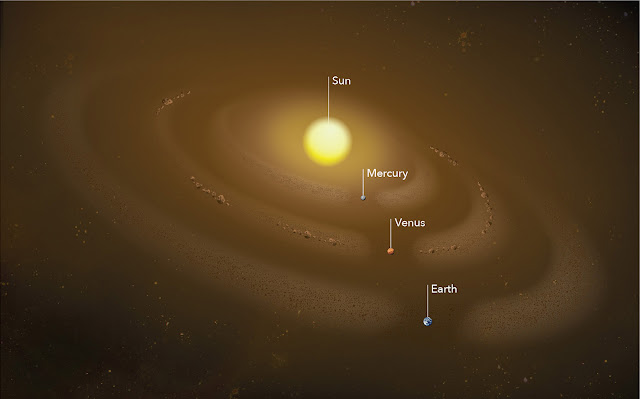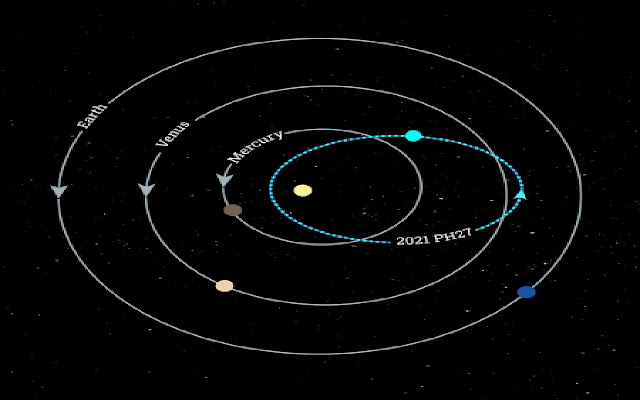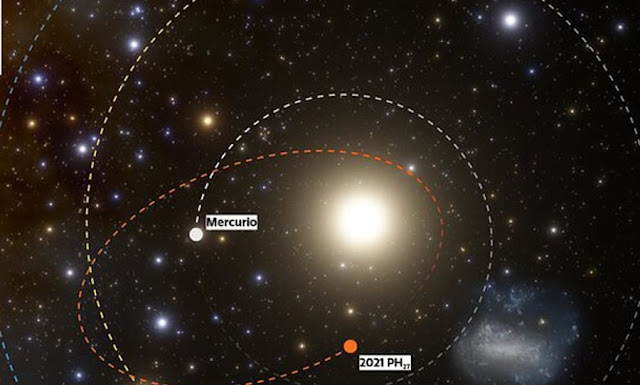Mercury Is No Longer The Closest World To The Sun
Chilean astronomers discovered an asteroid with the shortest orbital period of any known asteroid in the Solar System using the powerful 570-megapixel Dark Energy Camera (DECam).
They just completed this 10 days ago. The roughly one-kilometer-wide asteroid approaches the Sun by 20 million kilometers every 113 days (12 million miles or 0.13 au).

The asteroid 2021 PH27 has the lowest period and semi-major axis of any asteroid that is currently known to exist in our Solar System. The only planet with a shorter period and semi-major axis is Mercury. The asteroid experiences the highest general relativity effects of any known object in the Solar System due to its near proximity to the Sun.

Chilean astronomers discovered an asteroid with the shortest orbital period of any known asteroid in the Solar System using the powerful 570-megapixel Dark Energy Camera (DECam).
They just completed this 10 days ago. The roughly one-kilometer-wide asteroid approaches the Sun by 20 million kilometers every 113 days (12 million miles or 0.13 au).
The asteroid 2021 PH27 has the lowest period and semi-major axis of any asteroid that is currently known to exist in our Solar System. The only planet with a shorter period and semi-major axis is Mercury. The asteroid experiences the highest general relativity effects of any known object in the Solar System due to its near proximity to the Sun.
One of the top wide-field CCD imagers in the world is DECam. It was created for the Dark Energy Survey (DES), which was financed by the DOE. It was constructed and tested at Fermilab and operated by the DOE and NSF from 2013 to 2019. Currently, DECam is employed for a variety of science activities. The DECam science archive is maintained by the Community Science and Data Center (CSDC). The CTIO and CSDC initiatives are managed by the NOIRLab at NSF.
Twilight, just after sunset or just before sunrise, is the greatest time to search for asteroids that are inside Earth’s orbit and pointed in the general direction of Mercury and Venus. Any stargazer will tell you that Mercury and Venus usually appear to be close to the Sun in the sky and are always the easiest to spot just before or after sunrise or sunset. The same applies to asteroids that orbit near to the Sun.
David Tholen of the University of Hawaii calculated the location of 2021 PH27 after it was discovered and determined where it might be viewed the next night. After then, on August 14, 2021, it was once more examined by DECam and the Magellan Telescopes at the Las Campanas Observatory in Chile.
Then, on the evening of the 15th, Marco Micheli of the European Space Agency observed it from CTIO in Chile and from South Africa using the network of 1- to 2-meter telescopes at Las Cumbres Observatory. The newly discovered asteroid was also examined by other astronomers using DECam and Magellan.

According to Sheppard, astronomers are very willing to put their own science and observations on hold in order to pursue new, intriguing discoveries like this one, despite the fact that their telescope time is very valuable due to the international nature of their work and their love of the uncharted.
Oval-shaped orbits around the Sun are followed by planets and asteroids. The semi-major axis, which is the broadest portion of the oval, has a radius. 2021 PH27 has an elliptical orbit with a semi-major axis of 70 million kilometers (43 million miles or 0.46 au), giving it a 113-day orbital period and crossing the orbits of both Mercury and Venus.
It could have originally been located in the main asteroid belt between Mars and Jupiter, but gravitational perturbations from the inner planets caused it to drift closer to the Sun. On the other hand, it may be an extinct comet from the outer Solar System that was drawn into a tighter, shorter-period orbit as one of the terrestrial planets passed by due to its high orbital inclination of 32 degrees. We shall discover more about the asteroid’s origin when further observations are made of it.
Its orbit is likely unstable for extended periods of time as well. It is most likely going to collide with Mercury, Venus, or the Sun in a few million years or be forced out of the inner Solar System by the gravity of the inner planets.
Because the Sun’s radiation frequently obscures asteroids in the inner solar system, astronomers have difficulty locating them. Due to the Sun’s heat and gravitational tides, asteroids are subjected to a great deal of physical and thermal stress as they approach the Sun so closely. These forces might lead a few of the weaker asteroids to fragment.
“The number of asteroids that are close to Earth and Venus compared to those that are far away will tell us about their strength and make-up,” says Sheppard. If the number of asteroids in the same orbit as 2021 PH27 seems to be decreasing, it could tell astronomers how many near-Earth asteroids are loosely held together piles of rubble instead of solid chunks of rock. This could affect how we deal with asteroids that might be headed for Earth and how we try to stop them.
“Understanding the population of asteroids inside Earth’s orbit is important to finish the census of asteroids close to Earth,” says Sheppard. “Some of the most likely Earth-impacting asteroids may come close to Earth during the day, but they are hard to find in most surveys because they are done at night, when the Sun isn’t out.” He also says that since 2021 PH27 is so close to the Sun, “its surface temperature gets to almost 500 degrees C (around 900 degrees F) at closest approach, hot enough to melt lead.”
The closest object in the Solar System to the Sun, 2021 PH27, has the greatest effects of general relativity. This manifests as a very tiny precession of the asteroid’s elliptical orbit over time, which occurs at a rate of around one arcminute per century.
We can see the asteroid sliding behind the Sun from where we are right now. It’s known as a solar conjunction. Early in 2022, it is anticipated to return to Earth’s line of sight, allowing for further observations to more precisely pinpoint its orbit and give the asteroid a formal name.
Do not forget to share your opinion with us to provide you with the best posts !



0 Comments